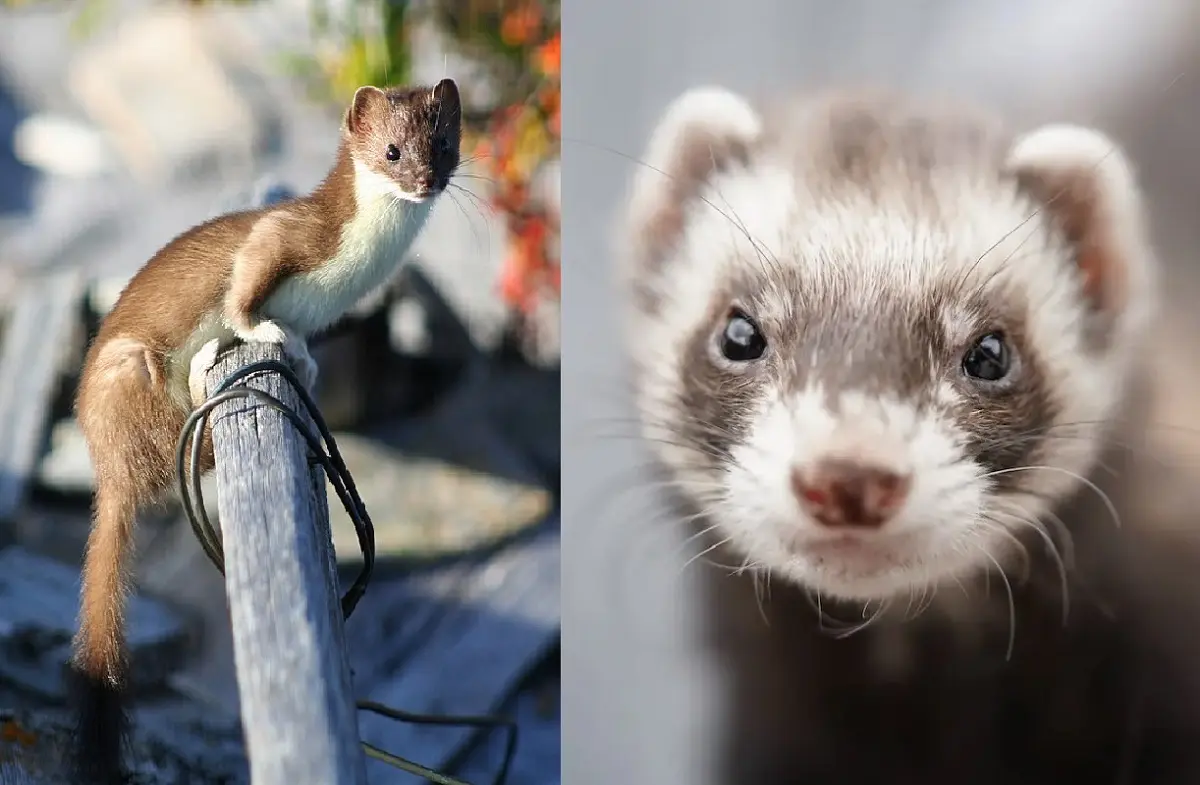Weasels and ferrets are small, carnivorous mammals that belong to the Mustelidae family. Although they share some similarities, they are two distinct species with unique characteristics and behavior.
In this article, we will discuss the key differences between weasels and ferrets, including their physical appearance, habitat, diet, behavior, and domestication.
Physical Appearance
Weasels:
- Weasels have slender, elongated bodies with short legs and long tails.
- They have a small, triangular-shaped head with sharp, pointed snouts and round ears.
- Weasels typically have brown fur on their backs and white or cream-colored fur on their bellies. Some species have a dark-colored tail tip.
- Weasels vary in size depending on the species, with the smallest being the least weasel (Mustela nivalis), measuring 4-10 inches in length, and the largest being the long-tailed weasel (Mustela frenata), which can grow up to 22 inches long.

Ferrets:
- Ferrets have a similar body shape to weasels, but they are generally larger and more robust.
- Their heads are more rounded, and their snouts are less pointed than weasels.
- Ferrets have a broader range of fur colors, including white, cream, brown, black, and various patterns. Domesticated ferrets may have unique coat colors and patterns due to selective breeding.
- Ferrets typically measure 18-24 inches in length, including their tail.
Habitat
Weasels:
- Weasels are found in various habitats, including forests, grasslands, and marshes, across North America, Europe, and Asia.
- They prefer environments with plenty of ground cover, which provides them with shelter and helps them hunt for prey.
- Weasels are known for their ability to adapt to different climates and environments, including arctic tundra and high-altitude regions.
Ferrets:
- Ferrets are native to Europe and parts of Asia, where they inhabit grasslands, forests, and wetlands.
- The European polecat (Mustela putorius), which is the wild ancestor of the domesticated ferret, has a similar habitat preference to weasels.
- Domesticated ferrets, however, are usually kept as pets and live in human-made environments.
Diet
Weasels:
- Weasels are strictly carnivorous and primarily feed on small mammals, such as mice, voles, and rabbits.
- They may also eat birds, eggs, insects, and reptiles, depending on their habitat and prey availability.
- Weasels have a high metabolism and need to consume food frequently to maintain their energy levels.
Ferrets:
- Ferrets are also carnivorous, with their wild counterparts feeding on similar prey as weasels.
- Domesticated ferrets require a diet high in protein and fat, typically consisting of specially formulated ferret food or raw meat.
- It is essential to avoid feeding ferrets foods high in carbohydrates, as their digestive systems are not equipped to process them.
Behavior
Weasels:
- Weasels are solitary creatures, only coming together during the breeding season.
- They are known for their agility and speed, which helps them catch their prey and escape predators.
- Weasels are primarily nocturnal, although they may be active during the day in some regions.
Ferrets:
- Wild ferrets, like weasels, are solitary and nocturnal.
- Domesticated ferrets, however, have been bred to be more social and can be kept in groups called “businesses.”
- Ferrets are curious, playful, and intelligent animals that enjoy exploring their environment and interacting with their owners.
- Domesticated ferrets can be trained to use a litter box and perform simple tricks.
Domestication
Weasels:
- Weasels have not been domesticated and are generally considered unsuitable as pets due to their aggressive nature and specialized dietary needs.
Ferrets:
- Ferrets have been domesticated for thousands of years, initially for hunting purposes (ferreting) and later as pets.
- Domesticated ferrets are more docile and friendly than their wild counterparts, making them popular pets in many countries.
- Ferrets require specialized care, including a proper diet, regular exercise, and mental stimulation to ensure their health and well-being. Here is a guide on how to care for pet ferrets.
Our Conclusion
While weasels and ferrets share some similarities, they are distinct species with unique characteristics. Weasels are smaller, wild animals with a more pointed snout and a strictly carnivorous diet.
Ferrets, on the other hand, are larger, more robust animals that have been domesticated and are commonly kept as pets. Their habitat, behavior, and domestication status further differentiate these two fascinating members of the Mustelidae family.
